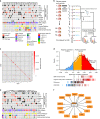Integrated pharmaco-proteogenomics defines two subgroups in isocitrate dehydrogenase wild-type glioblastoma with prognostic and therapeutic opportunities
- PMID: 32620753
- PMCID: PMC7335111
- DOI: 10.1038/s41467-020-17139-y
Integrated pharmaco-proteogenomics defines two subgroups in isocitrate dehydrogenase wild-type glioblastoma with prognostic and therapeutic opportunities
Abstract
The prognostic and therapeutic relevance of molecular subtypes for the most aggressive isocitrate dehydrogenase 1/2 (IDH) wild-type glioblastoma (GBM) is currently limited due to high molecular heterogeneity of the tumors that impedes patient stratification. Here, we describe a distinct binary classification of IDH wild-type GBM tumors derived from a quantitative proteomic analysis of 39 IDH wild-type GBMs as well as IDH mutant and low-grade glioma controls. Specifically, GBM proteomic cluster 1 (GPC1) tumors exhibit Warburg-like features, neural stem-cell markers, immune checkpoint ligands, and a poor prognostic biomarker, FKBP prolyl isomerase 9 (FKBP9). Meanwhile, GPC2 tumors show elevated oxidative phosphorylation-related proteins, differentiated oligodendrocyte and astrocyte markers, and a favorable prognostic biomarker, phosphoglycerate dehydrogenase (PHGDH). Integrating these proteomic features with the pharmacological profiles of matched patient-derived cells (PDCs) reveals that the mTORC1/2 dual inhibitor AZD2014 is cytotoxic to the poor prognostic PDCs. Our analyses will guide GBM prognosis and precision treatment strategies.
Conflict of interest statement
The authors declare no competing interests.
Figures






Similar articles
-
The Multifunctional Role of EMP3 in the Regulation of Membrane Receptors Associated with IDH-Wild-Type Glioblastoma.Int J Mol Sci. 2021 May 17;22(10):5261. doi: 10.3390/ijms22105261. Int J Mol Sci. 2021. PMID: 34067658 Free PMC article. Review.
-
Relevance of calcification and contrast enhancement pattern for molecular diagnosis and survival prediction of gliomas based on the 2016 World Health Organization Classification.Clin Neurol Neurosurg. 2019 Dec;187:105556. doi: 10.1016/j.clineuro.2019.105556. Epub 2019 Oct 12. Clin Neurol Neurosurg. 2019. PMID: 31639630
-
Molecular classification of IDH-mutant glioblastomas based on gene expression profiles.Carcinogenesis. 2019 Jul 20;40(7):853-860. doi: 10.1093/carcin/bgz032. Carcinogenesis. 2019. PMID: 30877769 Free PMC article.
-
TP53 mutated glioblastoma stem-like cell cultures are sensitive to dual mTORC1/2 inhibition while resistance in TP53 wild type cultures can be overcome by combined inhibition of mTORC1/2 and Bcl-2.Oncotarget. 2016 Sep 6;7(36):58435-58444. doi: 10.18632/oncotarget.11205. Oncotarget. 2016. PMID: 27533080 Free PMC article.
-
Isocitrate Dehydrogenase Wild-type Glial Tumors, Including Glioblastoma.Hematol Oncol Clin North Am. 2022 Feb;36(1):113-132. doi: 10.1016/j.hoc.2021.08.007. Epub 2021 Oct 30. Hematol Oncol Clin North Am. 2022. PMID: 34756799 Review.
Cited by
-
Biomaterial-based in vitro 3D modeling of glioblastoma multiforme.Cancer Pathog Ther. 2023 Jan 9;1(3):177-194. doi: 10.1016/j.cpt.2023.01.002. eCollection 2023 Jul. Cancer Pathog Ther. 2023. PMID: 38327839 Free PMC article. Review.
-
Integrated transcriptomics uncovers an enhanced association between the prion protein gene expression and vesicle dynamics signatures in glioblastomas.BMC Cancer. 2024 Feb 13;24(1):199. doi: 10.1186/s12885-024-11914-6. BMC Cancer. 2024. PMID: 38347462 Free PMC article.
-
Visualization of tumor heterogeneity and prediction of isocitrate dehydrogenase mutation status for human gliomas using multiparametric physiologic and metabolic MRI.Sci Rep. 2022 Jan 20;12(1):1078. doi: 10.1038/s41598-022-05077-2. Sci Rep. 2022. PMID: 35058510 Free PMC article.
-
Association of plasma cell-free DNA with survival in patients with IDH wild-type glioblastoma.Neurooncol Adv. 2021 Jan 16;3(1):vdab011. doi: 10.1093/noajnl/vdab011. eCollection 2021 Jan-Dec. Neurooncol Adv. 2021. PMID: 33615225 Free PMC article.
-
Leveraging the CSF proteome toward minimally-invasive diagnostics surveillance of brain malignancies.Neurooncol Adv. 2022 Oct 7;4(1):vdac161. doi: 10.1093/noajnl/vdac161. eCollection 2022 Jan-Dec. Neurooncol Adv. 2022. PMID: 36382110 Free PMC article.
References
-
- Stupp R, et al. Radiotherapy plus concomitant and adjuvant temozolomide for glioblastoma. N. Engl. J. Med. 2005;352:987–996. - PubMed
Publication types
MeSH terms
Substances
LinkOut - more resources
Full Text Sources
Medical
Molecular Biology Databases
Miscellaneous

